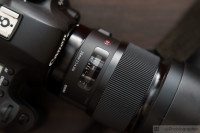
Hands-on with Sigma's APS-C primes for Canon at WPPI Sigma's DC DN EF-M primes have been the talk of the town for EF-M mount users for months now, but they've been in relatively short supply (we've only got the 56mm F1.
4 in the DPReview offices so far). But during our time at WPPI, we got a chance to see all three in-person and find out how they balance on Canon's latest APS-C mirrorless flagship, the EOS M6 Mark II.
Pictured above is the most compact of the three, and the most recently released – the 56mm F1. 4 DC DN. Offering an equivalent focal length of around 90mm (remember, Canon's APS-C crop is 1. 6x), it's a fantastic option for portraits. Actually, in the EF-M system, it's really the only native option for portraits, though you can of course make do with the kit zooms or adapt DSLR lenses.
As you can see, the 56mm is light on external controls, with only a large, rubberized manual focus ring on the exterior that is smooth and well-damped.
Sigma 56mm F1. 4 DC DN
Around the front of the lens is a 55mm filter thread, and down the barrel are nine aperture blades. The lens weighs 280g and feels dense without being heavy, and balances exceptionally well on the EOS M6 Mark II. It will focus down to 0. 5m (~20") with a maximum reproduction ratio of 0. 14x.
The optical formula is composed of 10 elements in six groups, including one 'super-low dispersion' element. Unfortunately, there's not much to see around the back of this lens. There's no rear gasket for keeping out moisture or dust on any of this trio of lenses.
Sigma 30mm F1. 4 DC DN
Up next is Sigma's 30mm F1. 4 DC DN. This lens is basically going head-to-head with Canon's EF-M 32mm F1. 4, but we don't mind a bit of competition. The Sigma gives you a 35mm-equivalent focal length of 48mm, while the Canon gives you 51. 2mm. That type of difference is unlikely to really influence your purchasing decision, though the Canon's much greater magnification ratio (0. 25x to 0. 14x) and higher price point ($479 to $339) might.
In any case, the Sigma 30mm F1. 4 balances quite well on the EOS M6 Mark II, being a bit lighter than the 56mm F1. 4 but a bit longer as well. A well-damped rubberized focus ring is likewise the only external control.
Sigma 30mm F1. 4 DC DN
The Sigma 30mm F1. 4 DC DN has an optical formula of nine elements in seven groups, with one of those elements being aspherical and another being double-sided aspherical. There are nine aperture blades and the front filter diameter is 52mm.
We actually reviewed this lens back nearer to its release, and on a Sony APS-C camera, we found it to be excellent.
Read our review of the Sigma 30mm F1. 4 for Sony E-Mount
Sigma 16mm F1. 4 DC DN
Last and largest is the Sigma 16mm F1. 4 DC DN. It's actually one-and-a-half times longer than the 56mm F1. 4, and the heaviest of the three by 125g, or more than a quarter of a pound.
This lens is likely to be of interest to EF-M users, who up until now had only one native wide-angle lens at their disposal: the excellent (but slower-aperture) 11-22mm F4-5. 6 zoom. This 16mm F1. 4 should be a great option for lower light shooting, events, astrophotography and more.
It balances fairly well on the EOS M6 Mark II, but is a bit front-heavy. It's not a very comfortable combination in the hand on Canon's grip-less EOS M200.
Sigma 16mm F1. 4 DC DN
Down the barrel, past the 67mm filter threads, we see a nine-bladed aperture, just like the other two. This should be great for creating 18-point sunstars in landscape scenes. In addition to being the biggest, it's also the most optically complex of the group, with 16 elements in 13 groups, including a total of seven specialty elements, and it can focus down to as close as 0. 25m (9. 84") for a maximum magnification of 0. 1x.
Hands-on with Sigma's APS-C primes for Canon at WPPI
And that's it for Canon's trio of DC DN F1. 4 prime lenses, now becoming readily available for EF-M mount. We find that these lenses make an enormous difference in the appeal of Canon's mirrorless APS-C system, but what do you think? Are you planning to pick any of these up for yourself? Let us know in the comments.
. dpreview.com2020-3-1 17:00





